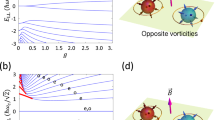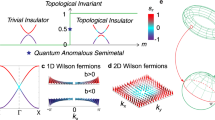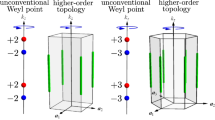Abstract
Fermions—elementary particles such as electrons—are classified as Dirac, Majorana or Weyl. Majorana and Weyl fermions had not been observed experimentally until the recent discovery of condensed matter systems such as topological superconductors and semimetals, in which they arise as low-energy excitations1,2,3,4,5,6. Here we propose the existence of a previously overlooked type of Weyl fermion that emerges at the boundary between electron and hole pockets in a new phase of matter. This particle was missed by Weyl7 because it breaks the stringent Lorentz symmetry in high-energy physics. Lorentz invariance, however, is not present in condensed matter physics, and by generalizing the Dirac equation, we find the new type of Weyl fermion. In particular, whereas Weyl semimetals—materials hosting Weyl fermions—were previously thought to have standard Weyl points with a point-like Fermi surface (which we refer to as type-I), we discover a type-II Weyl point, which is still a protected crossing, but appears at the contact of electron and hole pockets in type-II Weyl semimetals. We predict that WTe2 is an example of a topological semimetal hosting the new particle as a low-energy excitation around such a type-II Weyl point. The existence of type-II Weyl points in WTe2 means that many of its physical properties are very different to those of standard Weyl semimetals with point-like Fermi surfaces.
This is a preview of subscription content, access via your institution
Access options
Subscribe to this journal
Receive 51 print issues and online access
$199.00 per year
only $3.90 per issue
Buy this article
- Purchase on Springer Link
- Instant access to full article PDF
Prices may be subject to local taxes which are calculated during checkout




Similar content being viewed by others
References
Wan, X., Turner, A. M., Vishwanath, A. & Savrasov, S. Y. Topological semimetal and Fermi-arc surface states in the electronic structure of pyrochlore iridates. Phys. Rev. B 83, 205101 (2011)
Volovik, G. E. The Universe in a Helium Droplet (Oxford Univ. Press, 2009)
Weng, H., Fang, C., Fang, Z., Bernevig, B. A. & Dai, X. Weyl semimetal phase in noncentrosymmetric transition-metal monophosphides. Phys. Rev. X 5, 011029 (2015)
Huang, S.-M. et al. An inversion breaking Weyl semimetal state in the TaAs material class. Nature Commun. 6, 7373 (2015)
Xu, S.-Y. et al. Discovery of a Weyl fermion semimetal and topological Fermi arcs. Science 349, 613–617 (2015)
Lv, B. Q. et al. Experimental discovery of Weyl semimetal TaAs. Phys. Rev. X 5, 031013 (2015)
Weyl, H. Elektron und Gravitation. I. Z. Phys. 56, 330–352 (1929)
Silaev, M. A. & Volovik, G. E. Topological Fermi arcs in superfluid 3He. Phys. Rev. B 86, 214511 (2012)
Nielsen, H. B. & Ninomiya, M. The Adler–Bell–Jackiw anomaly and Weyl fermions in a crystal. Phys. Lett. B 130, 389–396 (1983)
Zyuzin, A. A. & Burkov, A. A. Topological response in Weyl semimetals and the chiral anomaly. Phys. Rev. B 86, 115133 (2012)
Hosur, P. & Qi, X. Recent developments in transport phenomena in Weyl semimetals. C. R. Phys. 14, 857–870 (2013)
Volovik, G. E. Kopnin force and chiral anomaly. JETP Lett. 98, 753–757 (2014)
Zhang, C. et al. Observation of the Adler–Bell–Jackiw chiral anomaly in a Weyl semimetal. Preprint at http://arXiv.org/abs/1503.02630 (2015)
Xiong, J. et al. Signature of the chiral anomaly in a Dirac semimetal: a current plume steered by a magnetic field. Preprint at http://arXiv.org/abs/1503.08179 (2015)
Huang, X. et al. Observation of the chiral-anomaly-induced negative magnetoresistance in 3D Weyl semimetal TaAs. Phys. Rev. X 5, 031023 (2015)
Xu, G., Weng, H., Wang, Z., Dai, X. & Fang, Z. Chern semimetal and the quantized anomalous Hall effect in HgCr2Se4 . Phys. Rev. Lett. 107, 186806 (2011)
Burkov, A. A. & Balents, L. Weyl semimetal in a topological insulator multilayer. Phys. Rev. Lett. 107, 127205 (2011)
Ali, M. N. et al. Large, non-saturating magnetoresistance in WTe2 . Nature 514, 205–208 (2014)
Nielsen, H. B. & Ninomiya, M. Absence of neutrinos on a lattice: (I). Proof by homotopy theory. Nucl. Phys. B 185, 20–40 (1981)
Soluyanov, A. A. & Vanderbilt, D. Computing topological invariants without inversion symmetry. Phys. Rev. B 83, 235401 (2011)
Yu, R., Qi, X. L., Bernevig, A., Fang, Z. & Dai, X. Equivalent expression of topological invariant for band insulators using the non-Abelian Berry connection. Phys. Rev. B 84, 075119 (2011)
Pletikosić, I., Ali, M. N., Fedorov, A. V., Cava, R. J. & Valla, T. Electronic structure basis for the extraordinary magnetoresistance in WTe2 . Phys. Rev. Lett. 113, 216601 (2014)
Brown, B. E. The crystal structures of WTe2 and high-temperature MoTe2 . Acta Crystallogr. 20, 268–274 (1966)
Acknowledgements
A.A.S., D.G., QS.W. and M.T. acknowledge the support of Microsoft Research, the Swiss National Science Foundation through the National Competence Center in Research MARVEL and the European Research Council through ERC Advanced Grant SIMCOFE. Z.W. and B.A.B. acknowledge the support of ARO MURI W911NF-12-1-0461, ONR-N00014-11-1-0635, NSF CAREER DMR-0952428, NSF MRSEC DMR-0819860, the Packard Foundation and a Keck grant. X.D. is supported by the National Natural Science Foundation of China, the 973 program of China (no. 2011CBA00108 and no. 2013CB921700) and the “Strategic Priority Research Program (B)” of the Chinese Academy of Sciences (no. XDB07020100).
Author information
Authors and Affiliations
Contributions
All authors contributed to performing the calculations and the analysis of the results.
Corresponding author
Ethics declarations
Competing interests
The authors declare no competing financial interests.
Supplementary information
Supplementary Information
This file contains Supplementary Text and Data, Supplementary Figures 1-13, Supplementary Tables 1-4 and Supplementary References. (PDF 2074 kb)
Rights and permissions
About this article
Cite this article
Soluyanov, A., Gresch, D., Wang, Z. et al. Type-II Weyl semimetals. Nature 527, 495–498 (2015). https://doi.org/10.1038/nature15768
Received:
Accepted:
Published:
Issue Date:
DOI: https://doi.org/10.1038/nature15768
This article is cited by
-
Ultrafast magnetization enhancement via the dynamic spin-filter effect of type-II Weyl nodes in a kagome ferromagnet
Nature Communications (2024)
-
Magnetodynamic properties of ultrathin films of Fe\(_{\textbf{3}}\)Sn\(_{\textbf{2}}\)-a topological kagome ferromagnet
Scientific Reports (2024)
-
High intrinsic phase stability of ultrathin 2M WS2
Nature Communications (2024)
-
Tilted Dirac superconductor at quantum criticality: restoration of Lorentz symmetry
Journal of High Energy Physics (2024)
-
Experimental observation of multiple topological nodal structure in LaSb2
Science China Physics, Mechanics & Astronomy (2024)
Comments
By submitting a comment you agree to abide by our Terms and Community Guidelines. If you find something abusive or that does not comply with our terms or guidelines please flag it as inappropriate.



